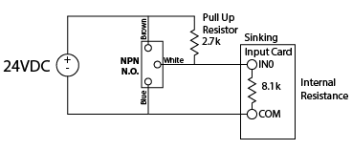To get technical, in this scenario it would be a pull up resistor. Realize too that technique also reverses the logic of the switch, N.O. become like a N.C. and vise versa.
You must also consider whether the voltage drop is acceptable. Consider the circuit in the diagram shown in the attached picture. For the purpose of explaining, the internal resistance is unusually low and made a nice value for calculations.
When the prox switch is not activated, all current will flow through the pull up resistor and through the internal resistance of the input card. This forms a voltage divider. If you calculate this out, you will get 18 volts on the input of the card. Will the card interpret 18 volts as on or off? It depends on the card, but the goal would be to be above the threshold for making the input as high/active. Also note the switch is off, but the input will be active, therefore reversing you logic.
If 18 volts is too low, the voltage making it to input card can be increased by lowering the value of the pull up resistor. But you must also consider the power dissipation of the resistor. When the NPN prox switch is active, it will pull the one side of the resistor to the dc common or 0v. Using your basic electrical calculations with 24V across a 2.7k resistor, you will come up with about 0.21 watts of power, therefore needing a 1/4 watt resistor. If your voltage drop is not acceptable and you have to lower the resistance, then you must consider how much higher do you need to go with the resistor power rating.






